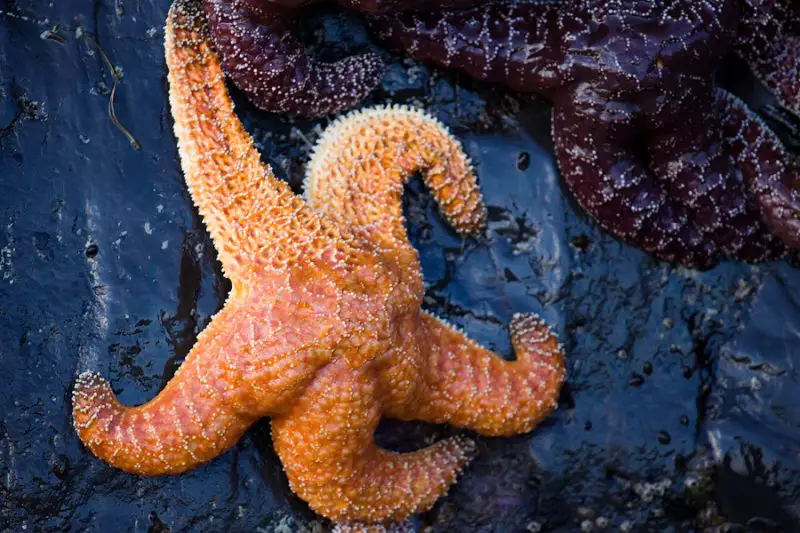The tide retreats from California’s rugged coastline, leaving pools that glisten like tiny mirrors. Beneath the rippling surface, bright shapes emerge — orange, purple, and ochre forms clinging tightly to rocks as waves crash nearby. To the casual beachgoer, they’re simply beautiful — the familiar starfish of tide pools. But beneath that calm exterior lies a story of resilience, regeneration, and survival that few truly understand.
The starfish in California are more than seaside decorations. They are architects of marine ecosystems, silent hunters, and survivors of one of the most devastating marine diseases ever recorded. Their lives — lived in intertidal zones shaped by sun, salt, and storm — reveal the delicate balance of ocean life along the Pacific coast.
This in-depth exploration unveils the hidden truths about California’s starfish: their biology, role in the ecosystem, mysterious die-offs, and the remarkable ability to heal themselves — one arm at a time.
Meet California’s Starfish

Sea Stars, Not Fish
The first thing to know is that starfish are not actually fish at all. Biologists prefer the term sea star, since these creatures belong to the phylum Echinodermata — the same family as sea urchins and sand dollars.
They breathe through tiny tube feet, have no blood (using seawater instead to move nutrients), and possess a simple nervous system capable of sensing light, touch, and chemicals in the water.
Despite their simplicity, sea stars in California are among the most remarkable invertebrates on Earth, capable of regeneration, complex hunting behavior, and ecological engineering on a massive scale.
Common Starfish Species in California
California’s coastline hosts dozens of sea star species, but a few dominate its tide pools and kelp forests.
-
Ochre Sea Star (Pisaster ochraceus) – The most recognizable and abundant species, famous for its bright orange or purple color and critical ecological role.
-
Bat Star (Patiria miniata) – Short-armed and smooth-skinned, common in both tide pools and deeper kelp forest regions.
-
Sunflower Star (Pycnopodia helianthoides) – The largest and fastest sea star in the world, with up to 24 arms and a top speed of one meter per minute.
-
Giant-Spined Sea Star (Pisaster giganteus) – Found in deeper rocky reefs, its thick arms and pale coloration help it blend with the ocean floor.
-
Leather Star (Dermasterias imbricata) – A soft-bodied, slippery species often covered in algae and marine life.
Each species plays a unique role in the food web — from predator to prey to ecosystem stabilizer.
Anatomy and Adaptation
Built for Ocean Life
The body of a starfish in California seems simple — a central disk with radiating arms. But under that skin lies an intricate system that rivals any biological design.
Their water vascular system acts like a hydraulic network, pumping seawater through canals that power hundreds of tube feet. These tiny suction cups allow sea stars to move, cling to rocks, and pry open prey like mussels and clams with astonishing strength.
The skin of most California sea stars is covered in calcium carbonate plates, giving them both armor and flexibility. Their vivid colors — purple, orange, red — are not for beauty alone but provide camouflage and protection against UV rays in shallow waters.
The Power of Regeneration
Perhaps the most famous fact — and one still awe-inspiring — is the sea star’s ability to regenerate lost arms. If a predator severs a limb, the sea star can regrow it within months, sometimes even regenerating an entire body from a single arm.
This regeneration is powered by stem cells distributed throughout their body — a biological mechanism still being studied for potential human medical applications.
In California’s turbulent intertidal zones, this ability is more than a curiosity; it’s a survival strategy, helping sea stars recover from injuries caused by waves, predators, or disease.
Life in the Tides
Between Ocean and Air
The starfish in California live in one of nature’s most extreme environments: the intertidal zone. Here, life alternates between submersion and exposure, between calm pools and violent surf.
When the tide recedes, sea stars cling tightly to rocks, sealing themselves against drying winds. Their tough skin helps prevent dehydration, while their tube feet grip surfaces with remarkable suction strength — sometimes holding on through waves powerful enough to topple people.
When the tide returns, they spring to life again, moving gracefully along rocks to hunt and feed.
Diet and Hunting Behavior
Sea stars are opportunistic predators. Their favorite prey includes mussels, clams, barnacles, snails, and even small crabs.
The Ochre Sea Star, in particular, is famous for its unique feeding method. Once it locates a mussel, it uses its tube feet to pry open the shell — even just a crack is enough. Then, in one of nature’s strangest feats, it ejects its stomach through its mouth, inserts it into the shell, and digests the mussel from the inside out.
This slow but effective process can last hours. When finished, the sea star retracts its stomach and moves on, leaving behind an empty shell — and a tidier ecosystem.
The Ecological Importance of Starfish
Keystone Species of the Pacific Coast
Few creatures have as profound an ecological role as the Ochre Sea Star. Ecologist Robert Paine’s landmark studies in the 1960s on Washington’s coast revealed that removing this species caused dramatic ecosystem collapse.
Without sea stars to control mussel populations, the mussels overran the rocks, crowding out dozens of other species. Paine coined the term “keystone species” to describe this effect — meaning that the entire ecosystem depends on their presence.
Along California’s rocky shores, the same principle applies. The starfish in California maintain balance in tide pool ecosystems by preventing any one species from dominating.
Without them, biodiversity would plummet, and the coast’s intricate web of life would unravel.
Reef and Kelp Forest Connections
In deeper waters, species like the Sunflower Star play similar roles, feeding on sea urchins that graze on kelp. After the sunflower stars’ massive population loss during recent disease outbreaks, sea urchin numbers exploded, devastating California’s kelp forests.
The absence of a single predator triggered cascading ecological consequences — a stark reminder of how fragile the ocean’s balance truly is.
The Mystery of the Starfish Wasting Disease
A Silent Catastrophe
In 2013, the Pacific coast witnessed one of the most severe marine die-offs in recorded history. Sea stars from Alaska to Baja California began showing strange symptoms: white lesions, deflation, twisted arms, and eventual disintegration.
The condition, known as Sea Star Wasting Syndrome, decimated populations within months. In some regions, over 90% of the starfish in California perished.
Scientists have since linked the disease to a densovirus, likely exacerbated by warmer ocean temperatures and stress. The event was a grim reminder of how climate change and environmental shifts can disrupt even ancient, resilient species.
Signs of Recovery
Despite the devastation, there’s hope. In recent years, divers and researchers along California’s central coast have reported sightings of juvenile Ochre Sea Stars returning to tide pools.
These young individuals represent nature’s slow but persistent attempt to restore balance. Their survival, however, depends on continued conservation of clean, healthy coastal habitats and stable ocean temperatures.
The comeback of California’s sea stars will take decades — but their resilience gives reason for optimism.
Reproduction and Life Cycle
A Dance of the Tides
The reproduction of sea stars in California is tied closely to the lunar cycle. Most species reproduce externally, releasing eggs and sperm into the water during late spring and early summer when tides and currents favor dispersal.
Fertilized eggs develop into free-swimming larvae that drift with the plankton before settling onto rocks and metamorphosing into miniature versions of adults.
This planktonic stage connects coastal ecosystems across vast distances — meaning sea stars born in Monterey might one day settle in Malibu or beyond.
Longevity and Growth
Depending on the species, sea stars can live anywhere from 5 to 35 years. Growth rates are slow, and many individuals don’t reach maturity for several years.
Because of this, mass die-offs have long-term effects — it can take a generation or more for populations of starfish in California to fully recover.
Their slow growth and dependence on stable conditions make them sensitive indicators of ocean health. When sea stars vanish, it’s often an early warning sign that the ecosystem is in distress.
Starfish and Human Connection
Symbols of Renewal and Mystery
Across cultures, sea stars have long symbolized healing, guidance, and renewal — fitting metaphors for creatures that can regrow lost limbs and survive in the planet’s most dynamic environment.
In California, they are woven into the coastal identity, appearing in art, jewelry, and tourism. For beachgoers, tide pools filled with vibrant sea stars offer a window into the complexity and beauty of marine life.
Yet, their true significance lies beneath symbolism: they are guardians of the intertidal world, quietly maintaining the rhythm of life where sea meets land.
A Fragile Relationship
Human fascination, however, can be a double-edged sword. Tide pool visitors often pick up or handle starfish, unaware that removing them from water can cause suffocation or tissue damage.
Even brief exposure to air or warm hands can harm these delicate creatures. Conservationists urge people to look, not touch — to appreciate from observation rather than interference.
Protecting starfish in California requires both admiration and restraint, ensuring future generations can marvel at their beauty without endangering their existence.
Conservation and Recovery Efforts
Monitoring the Comeback
Since the onset of wasting disease, scientists, divers, and citizen volunteers have monitored sea star populations along the California coast. Organizations like the Multi-Agency Rocky Intertidal Network (MARINe) conduct surveys to track recovery trends.
While Ochre Sea Stars are slowly returning in some regions, others — like the once-abundant Sunflower Stars — remain critically endangered.
Efforts to breed healthy stars in captivity and release them into the wild are underway, offering hope for future restoration.
Climate Change and Ocean Health
Rising ocean temperatures, acidification, and pollution continue to threaten sea stars in California. Warmer waters accelerate disease spread and reduce oxygen levels, while acidification weakens their calcium-based skeletons.
Protecting marine habitats, reducing carbon emissions, and regulating coastal runoff are crucial steps to preserving these keystone species.
As stewards of the Pacific coast, Californians hold a unique responsibility to safeguard the ecosystems that make the state’s shores so alive.
Surprising and Little-Known Facts About Starfish in California
-
Sea stars can move using hundreds of tiny hydraulic tube feet — no muscles required.
-
They have no brain or blood; seawater circulates through their vascular system instead.
-
Each arm contains parts of the digestive and reproductive systems.
-
Some starfish in California can regenerate an entire body from a single arm.
-
Their colors come from pigments that protect against UV rays and predators.
-
They can sense light through eyespots at the tip of each arm.
-
A single sea star can consume over 50 mussels per month.
-
The Sunflower Star can reach up to 40 inches in diameter.
-
The Sea Star Wasting Disease wiped out nearly 90% of the Pacific population in 2013–2015.
-
They’ve existed for more than 450 million years — long before dinosaurs.
FAQs About Starfish in California Waters
Are starfish native to California?
Yes. The sea stars in California are native species found along the Pacific coast, from San Diego to the northern rocky shores.
Can you pick up starfish from the beach?
No. Handling or removing them from water can cause stress and harm. Observing without touching is best.
What do sea stars eat?
They primarily feed on mussels, barnacles, snails, and detritus in tide pools and reefs.
Are all starfish the same color?
No. They come in a range of colors — orange, purple, red, and brown — depending on species and habitat.
Are starfish endangered?
Some species, such as the Sunflower Star, are critically endangered due to wasting disease and climate change.
How do starfish breathe?
They absorb oxygen directly from seawater through their tube feet and papulae (skin gills).
Do starfish have eyes?
Yes, each arm tip has a light-sensitive eyespot to detect brightness and movement.
What caused the starfish die-off in California?
A densovirus, worsened by warming seas, triggered Sea Star Wasting Syndrome that devastated populations.
How long do starfish live?
Depending on the species, they can live from 5 to 35 years.
How can people help protect them?
Avoid touching or collecting them, support marine conservation programs, and reduce pollution and carbon emissions.
Final Thoughts
The starfish of California are more than colorful ornaments of the sea — they are storytellers of resilience and balance. Their presence marks the health of the ocean; their absence warns of imbalance.
Through waves and disease, heat and hunger, they persist — rebuilding what’s lost, one arm at a time. Watching them cling to rocks between tides, we’re reminded that survival is not strength alone, but adaptability, patience, and quiet purpose.
The truth about starfish in California waters is simple yet profound: they are not just creatures of the tide, but architects of life itself, holding together the fragile edge where the land meets the sea.






